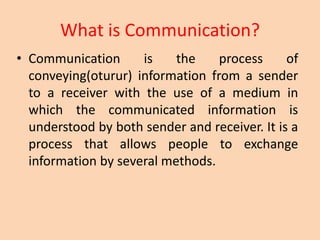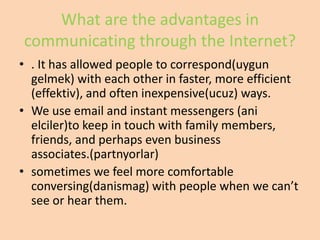Communication through internet.ppt
- 2. ŌĆó Modern life and business has become easier thanks to the contribution(tohfe) of the Internet technology. however(buna baxmayarag) it was not created overnight.(gefleten) It took a long time until networks(sebeke) could be connected together. From here the Internet has had a tremendous(neheng) impact(tesir) all over the world.
- 3. ŌĆó The foremost target(gabagcil hedef) of Internet has always been the communication. And Internet has excelled(otub kecmisdir) beyond(kenarinda) the expectations. Now we can communicate in a fraction(pay) of second with a person who is sitting in the other part of the world.
- 4. What is Internet? ŌĆó Internet is such an important thing nowadays. Most of us use it every day whether to search for information, to find friends and even to buy groceries. (erzaglar) ŌĆó The Internet is a global system of interconnected (elagelendirilen)computer networks that interchange( mubadile) data (melumat) by packet switching using the standardized Internet Protocol Suite(dest) (TCP/IP).
- 5. What is Communication? ŌĆó Communication is the process of conveying(oturur) information from a sender to a receiver with the use of a medium in which the communicated information is understood by both sender and receiver. It is a process that allows people to exchange information by several methods.
- 6. What are the advantages in communicating through the Internet? ŌĆó . It has allowed people to correspond(uygun gelmek) with each other in faster, more efficient (effektiv), and often inexpensive(ucuz) ways. ŌĆó We use email and instant messengers (ani elciler)to keep in touch with family members, friends, and perhaps even business associates.(partnyorlar) ŌĆó sometimes we feel more comfortable conversing(danismag) with people when we canŌĆÖt see or hear them.
- 7. ŌĆó Email is readily available (memnuniyyetle mumkun)to anyone who has Internet access (giris)also. There are several free email providers, such as Yahoo! and Hotmail.
- 8. Using Symbols: Emoticons ŌĆó The special characteristic of instant messengers is that you can use emoticons to express feelings and other actions. Emoticons are images that appear after the user has typed in a code.
- 9. Email Communication ŌĆó Email communication is now used by thousands of people every day. They use it to send documents for business or school, to catch up(catmag) on the latest news with their friends and family, or to send pictures, jokes, and forwards.(ireli) ŌĆó It is phenomenal, and it happens without the use of paper, pens, envelopes, and stamps ŌĆó Most instant messengers are free, communicating with them not only fast, it's also cheap!.
- 10. What are the disadvantages in communicating through the Internet? 1. Although there are many advantages to email, there are also several negative aspects too. While writing a letter can be as simple as picking up a pen and writing words on paper, composing an email can be much more complicated. Despite efforts by email providers to simplify email composition, still, writing an email can be a difficult task for the computer illiterate.
- 11. ŌĆó For example: ŌĆó John Smith: ŌĆ£My mother is one of those people who sees computers, specifically(xususile) internet knowledge, as a foreign languageŌĆöa language sheŌĆÖd be able to survive without knowing, and therefore, sheŌĆÖs very reluctant(hevessiz) to learn. She recently broke down and got an email account so that she could keep in touch with my sister and me while we are away at school. It has taken numerous(coxlu) lessons from my sister, my father, and me to get her to the point where she understands just enough that she can write an email and reply to oneŌĆØ.
- 12. 2. Besides the complication aspect, there are other cons to using email. While you can send electronic packages through email, such as attachments containing text or pictures, you canŌĆÖt send actual three dimensional (olculu)packages.
- 13. 3. Another negative aspect of emails is receiving unwanted mail and attachments. Businesses can send out junk(kohne kuruw) mail to you email accounts just like they send junk mail to your mailboxes at home. Besides junk mail, you may receive forwards containing useless information that can waste your time, or you may receive viruses through emails that can destroy the hard drive on your computer.
- 14. 4. A very important con of email communication is the possibility of being misunderstood. Because you cannot see or hear the person with whom you are communicating and vice versa, there is a chance that something that is said may be misinterpreted(tehrif edilen). If, for example, a friend sends you an email and says something with sarcasm, you may not pick up on the sarcastic tone. This is because you canŌĆÖt hear their voice as they say it, and it can cause arguments and hurt feelings.
- 15. 5. When speaking on instant messengers, we are cut off (gacin) from those visual and audio clues that we usually rely so heavily on, often without thinking about it, in face-to-face conversations. 6. As with email, it is possible to receive viruses through instant messengers. It is important to be cautious(ehtiyatli) when people send you files over the instant messengers. Anytime someone sends you a file, think carefully before accepting it.
- 16. Conclusion Netice ŌĆó Despite(baxmayarag) certain cons of using email and instant messengers, both communication mediums are popular and convenient. Today, more and more people use email and instant messengers to communicate with each other. They give people the chance to correspond with one another in fast, cost effective ways.















